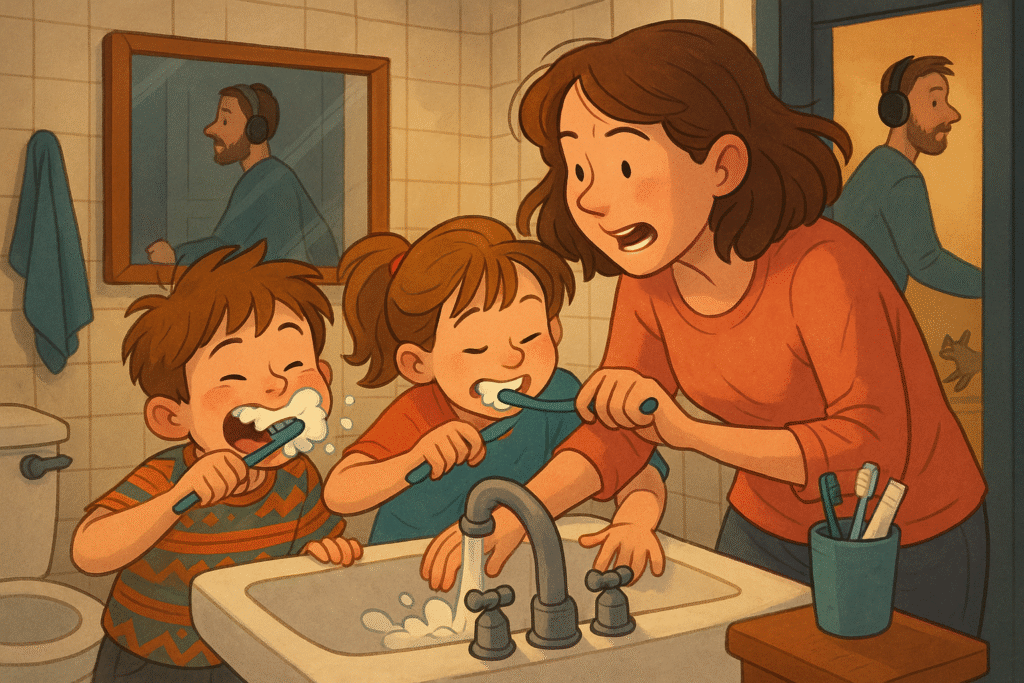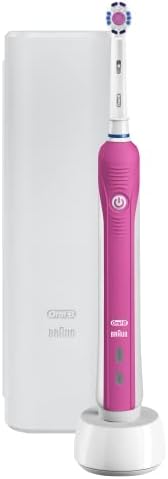Electric & Smart Toothbrushes (UK 2025)

Short answer: Electric toothbrushes—especially oscillating-rotating models—tend to remove more plaque and reduce gum bleeding than manual brushes. “Smart” (Bluetooth/app) features can help with habits (time, coverage, pressure), but the brush you’ll actually use correctly twice a day is the winner.
- Who this is for: Adults, parents, and carers choosing an electric or smart toothbrush.
- What you’ll get: Evidence-based buying advice, kids’ tips, how-to technique, best-value picks, and FAQs.
What’s in this guide
- Why dentists recommend electric toothbrushes
- How oscillating-rotating vs sonic brushes work
- Features that actually matter
- Smart/Bluetooth toothbrushes explained
- Electric toothbrushes for kids
- How to use an electric toothbrush properly
- Best value picks (UK 2025)
- FAQs
- Sources & evidence
1) Why dentists recommend electric toothbrushes
Large reviews show powered brushes reduce plaque and gingivitis more than manual brushing over time. In practice, timers, pressure sensors and small heads help people brush long enough, gently, and tooth-by-tooth—so results are easier to achieve consistently.
- Bottom line: If budget allows, choose electric. Manual can be effective, but most people get better results with powered brushing.
2) How oscillating-rotating vs sonic brushes work
| Type | How it works | Pros | Considerations |
|---|---|---|---|
| Oscillating-rotating (e.g., Oral-B) | Small round head rotates back-and-forth rapidly | Strong evidence for plaque removal; great at gumline; small head reaches back teeth | Distinct “power” feel; some models a bit louder |
| Sonic (e.g., Philips Sonicare) | Longer head vibrates side-to-side at high frequency | Smoother, quieter feel; gentle for sensitive users | Effectiveness close, but OR tends to edge it in studies |
3) Features that actually matter
- 2-minute timer + quad-pacer: Ensures full time and even coverage.
- Pressure sensor: Stops you pressing too hard (protects gums).
- Small soft brush heads: Better access, safer on gums.
- Rechargeable handle: Stable power vs disposable batteries.
- Head availability/cost: Replace every ~3 months.
Nice-to-have: multiple modes (sensitive/whitening), travel case. Mostly marketing: lots of “modes”, flashy screens—helpful but not essential.
4) Smart/Bluetooth toothbrushes explained
Apps can coach technique (coverage maps), keep time, and warn on pressure. Studies suggest small but real behavioural gains—especially for children or anyone building better habits. Once your technique is solid, the extra benefit is modest.
- Best use cases: kids, low motivation, correcting technique, gum problems from heavy pressure.
5) Electric toothbrushes for kids
- Under 6: Child-specific electric brushes (small, soft heads, gentle power) with supervision.
- 6–12: Step up power gradually; gamified apps/timers help build routine.
- Braces: Electric often cleans better around brackets; swap heads a bit more often (~2 months).
6) How to use an electric toothbrush properly
- Use a pea-sized amount of fluoride toothpaste.
- Place at a 45° angle to the gumline. Let the brush do the work—don’t scrub.
- Move tooth-by-tooth; spend ~30s per quadrant (follow the pacer).
- Gently brush the tongue or use a tongue scraper.
- Spit, don’t rinse—leave fluoride on the teeth.
7) Best value picks (UK 2025)
Great value (most people)
- Oral-B Smart 4 — oscillating-rotating, timer, quad-pacer, pressure sensor, Bluetooth app. Often excellent twin-pack deals.
- Oral-B Pro 3 — similar cleaning without Bluetooth; very good price/performance.
If you prefer sonic
- Philips Sonicare ProtectiveClean 4300 — gentle, effective, pressure sensor, easy heads.
Premium smart feel
- Oral-B iO Series 6 — quieter drivetrain, refined pressure control, app coaching. Nice to have, not essential.
Tip: Prioritise head availability/cost and a pressure sensor over fancy screens.
Are electric toothbrushes better than manual ones?
Most dentists agree that electric toothbrushes clean more effectively than manual brushes, especially oscillating-rotating models such as Oral-B.
Studies show they remove more plaque and reduce gum bleeding by around 10–20% over several months.
Manual brushes can still work well — but only if you use the right technique for a full two minutes twice a day.
What type of electric toothbrush do dentists recommend?
Dentists usually recommend oscillating-rotating brushes (with small round heads) rather than simple sonic ones.
Look for these key features:
Two-minute timer
Pressure sensor
Soft, replaceable heads
Rechargeable battery
Good examples include the Oral-B Pro 3 or Smart 4, or the Philips Sonicare ProtectiveClean 4300.
Do smart or Bluetooth toothbrushes really make a difference?
Smart toothbrushes can help by coaching your brushing technique.
Apps show which teeth you’ve missed, remind you to brush for long enough, and sometimes reward you with points or badges.
They work best for:
Children learning good habits
Adults who need motivation
People trying to correct poor technique
If you already brush thoroughly, the app won’t change much — but it can make brushing more fun and consistent.
Are electric toothbrushes safe for children?
Yes.
Many paediatric dentists — and even the NHS — say electric brushes can make brushing easier and more enjoyable for kids, especially if they dislike manual brushing.
Use a child-specific brush with a small, soft head and gentle settings (for example, Oral-B Kids Disney+ or Philips Sonicare For Kids).
How often should I change the brush head?
Every three months, or sooner if the bristles start to splay.
Worn bristles clean less effectively and may damage gums.
Can electric toothbrushes damage gums or enamel?
Not if used correctly.
Most modern brushes have pressure sensors that warn you if you press too hard.
Gum recession usually comes from excessive pressure or hard bristles, not from the motor itself.
Always let the brush do the work — just guide it gently along the gumline.
Are electric toothbrushes worth the money?
For most people, yes.
They tend to clean better, are easier to use, and make it simpler to stick to good routines.
A mid-range model (£60–£100) with a timer and pressure sensor is usually the best value — you don’t need the most expensive “AI” version unless you enjoy the tech.
Which is better — oscillating-rotating or sonic?
Both are effective, but research slightly favours oscillating-rotating brushes for plaque removal.
Sonic brushes feel smoother and quieter, so they can suit people with sensitive gums.
The difference is small — it’s more important to use the brush properly.
Do dentists actually use electric toothbrushes themselves?
Most do.
Surveys of dental professionals show over 70% use electric brushes for their own oral care.
They recommend them because they see the results directly in patients — cleaner teeth and healthier gums at check-ups.
What’s the best way to brush with an electric toothbrush?
Apply a pea-sized amount of fluoride toothpaste.
Hold the brush at a 45° angle to the gumline.
Let the brush move tooth-by-tooth — don’t scrub.
Spend 30 seconds per quadrant (top right, top left, bottom right, bottom left).
Spit out the foam but don’t rinse with water — leave the fluoride to work.
Can people with braces use electric toothbrushes?
Absolutely — in fact, they often work better than manual brushes for cleaning around brackets and wires.
Choose a small-headed brush with a pressure sensor, and replace the head more often (every 2 months).
You can also add an interdental brush or water flosser for hard-to-reach areas.
What about people with sensitive teeth or gums?
Choose a model with a sensitive mode or a soft brush head.
Use fluoride toothpaste for sensitive teeth, and avoid pressing too hard.
If soreness continues, see your dentist — it could signal gum disease or enamel wear.
Do any health organisations recommend electric toothbrushes?
American Dental Association (ADA) gives its Seal of Acceptance to several electric models.
The Australian Dental Association lists them as “proven aids to oral hygiene.”
The NHS and European Federation of Periodontology say electric brushes can make brushing easier and more effective, especially for those with poor dexterity.
Do electric toothbrushes help with bad breath?
They can — because they remove plaque and bacteria more efficiently, particularly around the gumline and back of the tongue.
For best results, brush twice a day, clean your tongue gently, and floss or use interdental brushes daily.
What’s the most important thing — brush type or technique?
Technique, every time.
An electric toothbrush can help you do it right, but brushing twice daily for two minutes with fluoride toothpaste is what truly protects your teeth.
9) Sources & evidence
- NHS guidance on cleaning teeth and gums (manual or electric can be effective with good technique).
- Professional reviews/meta-analyses showing powered brushes reduce plaque/gingivitis vs manual.
- Periodontal bodies and dental associations listing powered brushes as valid aids (e.g., ADA Seal, Australian Dental Association).
- Evidence: Electric (Powered) Toothbrushes vs Manual Brushes
Many good studies and reviews show that powered toothbrushes (especially oscillating-rotating types) tend to clean better and improve gum health more than manual brushes. Here’s what they found:
🔍 Key Research Findings
Systematic review: powered brushes better than manual
A big review looked at many clinical trials. It concluded that powered brushes remove more plaque and reduce gum inflammation (gingivitis) more than manual brushing.
Full article:
https://pmc.ncbi.nlm.nih.gov/articles/PMC9303421/
Cochrane Review (gold standard)
The Cochrane Collaboration reviewed many randomized trials and found that, over 3 months or more, powered toothbrushes (especially oscillating-rotating ones) reduced plaque and gingivitis more than manual brushes.
(You can find Cochrane reviews on toothbrushing effectiveness in dental care journals.)
Real-world / observational data
In everyday use, people using powered brushes (sometimes with app feedback) have been shown to have lower gum bleeding rates and better brushing habits. One large user-data analysis over weeks showed self-reported gum bleeding declined among people using app-enabled powered brushes.
Orthodontic / challenging conditions
In patients with braces (teeth with wires), an “interactive” powered brush was better at controlling plaque around brackets than a manual brush over several months.
Study: https://pubmed.ncbi.nlm.nih.gov/33384265
In dental student trial
Dental students using a powered brush (with or without an app) cleaned better and had less gum bleeding than those using manual brushes, over an 8-week trial.
Study: https://www.researchgate.net/publication/360858926
🧠 What the Evidence Means (in simple terms)
Powered = more forgiving: If your angle, pressure, or timing aren’t perfect, an electric brush helps cover up small mistakes.
Better at hard spots: Electric brushes reach places that are harder to clean manually (back molars, along gums).
Consistency & behaviour help: Features like timers and sensors help people brush properly more often.
⚠️ What to keep in mind / limitations
The extra benefit from powered over manual is real, but not enormous. If you brush perfectly with a manual, results may be similar.
Many studies are short (weeks to months). We still need longer studies over years.
User commitment matters: if you don’t use the brush correctly, or forget to change the head, benefits are lost.
Quality of brush matters: not all electric brushes are equally good — the best ones (good design, pressure sensor, timer) make the biggest difference.
Evidence for: What Do Dentists Think About Electric Toothbrushes?
Here at DigitalHealthCoachUK we always check out the evidence behind any claims.
Most dentists and dental hygienists say that electric toothbrushes can help people clean better and keep gums healthier. Several surveys around the world show that many professionals now recommend them, especially for people who struggle to brush well with a manual toothbrush. Here are some examples.
1. International Federation of Dental Hygienists (IFDH) Global Survey, 2020
The IFDH asked 4,345 dental hygienists in 36 countries about electric toothbrushes.
- 96% said they recommend electric toothbrushes to patients (79% “Yes, often”; 17% “Yes, sometimes”).
- 90% agreed that patients who use electric toothbrushes usually have healthier gums.
- Only 16% believed patients actually go out and buy one after being told to.
- About half said they use research papers to guide their advice; others rely on experience or colleagues.
Full survey PDF: https://ifdh.org/wp-content/uploads/2022/09/IFDH-Electric-Toothbrush-Survey-Results.pdf
Follow-up white paper: https://pmc.ncbi.nlm.nih.gov/articles/PMC10946314/
2. Dentists’ Knowledge and Attitude Study (Saudi Arabia, 2019)
In 2019, researchers Al-Kattan & Al-Shibani surveyed 417 dentists about their views on electric toothbrushes.
- 65% said the main benefit is better patient compliance (people brushing more regularly and for longer).
- 77.9% said that poor brushing habits are the biggest cause of plaque build-up.
- 76.5% said they recommend electric brushes especially for patients with arthritis or poor hand control.
3. “The Role of Dental Practitioners in Promoting Electric Toothbrushes” (2025)
This newer study looked at 302 dental professionals (students, private dentists, and faculty).
- 72.5% had prior knowledge of electric toothbrushes.
- 68.2% believed electric brushes improve oral care.
- 61.3% had never recommended them in practice, even though most said they planned to start doing so.
Full text: https://pmc.ncbi.nlm.nih.gov/articles/PMC12156671/
4. Orthodontic Hygiene Practices Survey (IFDH)
The same international group also asked dental hygienists how they help patients with braces or aligners keep their teeth clean.
- 69% said they recommend electric toothbrushes for people with fixed braces.
- 77% recommend them for patients with removable orthodontic appliances.
Survey results: https://ifdh.org/ifdh-orthodontic-hygiene-practices-survey/
🧩 What This All Means
- Most dental professionals believe electric toothbrushes work well and help people who find manual brushing tricky.
- Hygienists almost always recommend them. Dentists often do too, but not all patients take the advice.
- There is strong agreement that electric brushes are especially helpful for people with poor brushing habits, braces, or reduced hand movement.
- Some dentists still stick with “manual or electric—either is fine if you use good technique” to keep costs down for patients.
In short: most dental professionals support electric toothbrushes, and surveys show that they recommend them widely. Some patients still prefer manual brushes, but if you can afford an electric one and use it properly, most dentists say it’s the easier way to brush well.
Quick recommendation: For most people in the UK, an oscillating-rotating brush with a timer and pressure sensor (e.g., Oral-B Smart 4 or Pro 3) offers the best balance of cleaning performance and price.



![Philips Sonicare 5500 Electric Toothbrush, Sonic Toothbrush with 1 Intensity Level, Pressure Alert, EasyStart, SmarTimer and BrushPacer, White, Model HX7110/01 [New Technology]](https://m.media-amazon.com/images/I/41-Pqdu-JWL._AC_.jpg)
